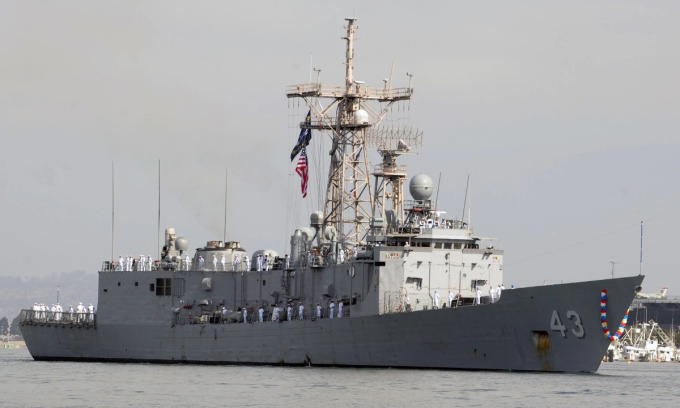
President-elect Donald Trump has expressed dissatisfaction with the inefficiency and expense of U.S. warship production, arguing that it hinders America's ability to compete with China’s rapidly expanding naval fleet.
According to a January 14 report by Defense News, the U.S. Navy aims to increase its fleet from 296 to 381 ships by 2054 to counter growing global threats. This ambitious plan involves adding 85 new warships over the next 30 years at an estimated cost of $1.2 trillion. However, Trump has criticized such expenditures as wasteful and has signaled his intent to overhaul defense spending as he prepares to assume office.
Concerns Over Costly Shipbuilding Programs
In a recent interview with conservative host Hugh Hewitt, Trump criticized the U.S. Navy’s procurement process for a new class of warships. He attributed rising costs to design changes made under the Biden administration, which he said undermined efficiency.
“I had negotiated a great contract to build what is essentially a destroyer. It was beautiful and fit for purpose,” Trump said. “But then generals and admirals stepped in, saying, ‘Why not make it a little wider? Why not change this and that?’ Unfortunately, they lack the intelligence to keep it simple, and now it’s worse and more expensive.”
Although Trump did not name the specific program, his remarks appear to target the Navy’s Constellation-class frigate initiative, which began in July 2017. These guided-missile frigates, weighing 6,700 tons, are based on the European FREMM design used by the French and Italian navies.
In 2020, during Trump’s first term, the Pentagon awarded a contract to Italian shipbuilder Fincantieri to design and build the Constellation-class ships. The Navy plans to spend $22 billion on at least 20 of these frigates, but the program has faced delays and cost overruns due to design modifications, including an extended hull and larger diesel generators to accommodate additional weaponry.
The first Constellation-class frigate began construction in August 2022 at Fincantieri’s Wisconsin shipyard, despite the detailed design not being finalized. This led to repeated delays and cost increases, with the per-ship price rising from $1.2 billion to $1.6 billion. Delivery of the first vessel, initially scheduled for April 2026, is now expected to be delayed by three years.
Challenges in U.S. Shipbuilding
According to the U.S. Naval Institute, the Constellation-class design initially retained 85% similarity to the FREMM design but has since diverged significantly due to ongoing modifications. Analysts note that the delays and budget increases reflect broader challenges in U.S. shipbuilding, including labor shortages, supply chain issues, and limited industrial capacity.
“China appears to produce new warships every four days, while the U.S. watches,” Trump said during his interview. He emphasized the need for the U.S. to work with allies to streamline ship production until domestic capacity improves.
The U.S. currently operates only four state-owned shipyards and a limited number of private facilities, making it difficult to meet the Navy’s requirements. Meanwhile, China has the world’s largest navy by fleet size, with over 370 ships, including 140 large surface combatants, according to the 2024 China Military Power Report.
A Vision for Change
Trump has pledged to revitalize U.S. naval shipbuilding to counter China’s maritime dominance. In April 2023, he promised to modernize the Navy’s shipbuilding capabilities. Last month, he nominated John Phelan, a businessman with financial expertise but no military background, as Secretary of the Navy. Trump praised Phelan as a “brilliant entrepreneur” who could bring fiscal discipline to the Navy’s operations.
Experts believe Trump’s focus on appointing financially savvy leaders signals a priority on cost-effectiveness in defense spending. Timothy Heath of the RAND Corporation noted that international collaboration in shipbuilding could accelerate production while reducing costs.
“In today’s globalized manufacturing landscape, no single country can produce every component for sophisticated systems like warships,” Heath explained. “Allies and partners can contribute key components more efficiently and at lower costs.”
Strategic Importance of the Constellation-Class Frigates
The U.S. Navy’s decision to return to frigates follows the troubled Littoral Combat Ship (LCS) program, which suffered from delays, design flaws, and ballooning budgets. Unlike the lighter LCS, Constellation-class frigates are designed for high-speed escort missions and protecting other vessels from aerial, surface, and underwater threats.
Despite these challenges, analysts agree that increasing the Navy’s fleet size is critical for maintaining U.S. military dominance. Trump’s approach of cost containment and efficiency improvements aims to address these systemic issues while ensuring the Navy can keep pace with global threats.
“China’s shipbuilding industry is sending an unprecedented message,” Trump said, emphasizing the urgency for the U.S. to act. “We need more ships, and we need them fast.”
(Reported by Newsweek and Hugh Hewitt)
Hello Shuttle will strive to bring the latest updates. At the end of the day.
Are you looking for reliable airport and cruise port transfer services in Los Angeles?
We offer professional, safe, and punctual transportation from
Los Angeles Airport - LAX
Long Beach Airport - LGB
John Wayne Airport - SNA
San Pedro cruise port
Long Beach cruise port
Disneyland
and other destinations.
Let us make your journey stress-free and comfortable with our dedicated drivers and high-quality vehicles. Book now for the perfect travel experience at www.helloshuttle.com or call 944-800-5678!


